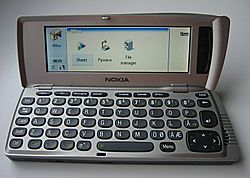Nokia 9210 Communicator
 | |
| Manufacturer | Nokia |
|---|---|
| Compatible networks | EGSM 900/1800 and HSCSD (43.2 kbit/s)[1] |
| First released | June 2001[1] |
| Predecessor | Nokia 9110 Communicator |
| Successor | Nokia 9300 Nokia 9500 Communicator |
| Dimensions | 158 × 56 × 27 mm[1] |
| Mass | 244 g[1] |
| Memory | Application 14 MB, user 2 MB[1] |
| Removable storage | 16 MB Multi Media Card[1] |
| Battery | BLL-3 (1300 mAh)[1] |
| Display | 4096-color 640 × 200 LCD screen[1] |
| External display | Mono |
The Nokia 9210 Communicator is a third-generation Communicator series mobile phone produced by Nokia, announced on 21 November 2000[2] and released in June 2001. It greatly improved on the second generation Nokia 9110 Communicator, providing a colour main screen and using an ARM processor. It is one of the few mobile phones able to send and receive fax.
It was the first device to run on the Symbian OS platform,[3] version 6, succeeding version 5 of EPOC. It also introduced Nokia's Series 80 interface, which was the result of Symbian Ltd.'s 'Crystal' design.[4]
It is used as a normal though bulky mobile phone in closed mode; when it is flipped open it can be used like a very small notebook computer with a 640 × 200 screen.[1] The earpiece and microphone are located on the back so one must hold it with the front screen and keypad facing out to make a call. The phone also has speakerphone functionality.
The 9210 Communicator's success helped Nokia overtake both Palm and Compaq to become the leading 'mobile data device' vendor in Western Europe in the third quarter of 2001, when it had a 28.3 percent share in the market.[5]
Specifications[edit]
- Main applications: mobile phone, desk application, messaging (SMS, fax, email), Internet (web, WAP), contacts (address book), calendar, office (word processor, spreadsheet, presentation viewer, file manager)
- Extra applications: calculator, clock, games, recorder, and unit converter. In addition, 3rd party software developers could freely implement new applications for the Nokia 9210 Communicator and offer them for download by the users.
- Processor: 32-bit 66 MHz ARM9-based RISC CPU
- Total memory: 24 MB
- Application memory: 14 MB
- User memory: 2 MB
- Execution memory: 8 MB (SD-RAM)
- 16 MB Multi Media Card in the sales package
- Operating frequency: GSM-900/1800 networks in Europe, Africa, Asia
- Radio: foldout antenna for improved reception.
- Operating system: Symbian OS v6.0, Series 80 v1.0
- Interface: IrDA but no Bluetooth, Serial port cable for PC.
- Audio: Stereo-headset, mp3-player software is optional, additional internal speaker for music and full-duplex speakerphone functionality.
- Includes PC Suite for the Nokia 9210 Communicator, running on Windows platform.
- Vibrating alert: not implemented.
9210i[edit]

The 9210i launched in 2002 increased the internal memory to 40 MB and adds the RealPlayer for video streaming. The web browser now supports Flash 5 and HTML 4.01 instead of HTML 3.2 on the 9210. The main screen backlight was also changed from high voltage CCFL tube light to LED backlight, which was quite new technology at the time.[6]
- Total memory: 40 MB
- Application memory: 16 MB
- User memory: 16 MB
- Execution memory: 8 MB (SD-RAM)
- 64 MB Multi Media Card in the sales package
Replacement models[edit]
Nokia replaced the 9210 in first quarter of 2005 with:[7]
- Nokia 9500 – has additional features (Wi-Fi and camera) but is smaller 148 mm × 57 mm × 24 mm) and lighter (222 g), and has an updated Symbian Series 80 operating system.
- Nokia 9300 – is smaller (132 mm × 51 mm × 21 mm) and lighter (167 g) than Nokia 9210, with similar features and the same operating system as the Nokia 9500.
Both new models include other improvements such as: EDGE, colour external displays and Bluetooth.
Accessories[edit]
- Camera
- Hands free car kit
Nokia 9290[edit]
The American variant of the 9210i is the Nokia 9290 supporting GSM-1900, first introduced on 5 June 2001 and eventually, after a year-long delay, released on the continent in June 2002.[6]
In popular culture[edit]
In the music video for "Dilemma" by Nelly featuring Kelly Rowland, the Nokia 9210 phone can be observed being utilized by Kelly Rowland.
See also[edit]
References[edit]
- ^ a b c d e f g h i "Nokia 9210 Communicator Device Specs". PhoneDB. 16 October 2007. Retrieved 28 September 2019.
- ^ "The Nokia 9210 Communicator heralds the dawn of mobile multimedia". Nokia (Press release). 21 November 2000. Archived from the original on 12 December 2013. Retrieved 1 October 2019.
- ^ Duální wapový komunikátor. Aktualityː komunikace. Chip. Praha: Vogel Publishing, 19 December 2000, vol. 11, issue 01 (january 2001), p. 12. Retrieved 01 July 2023. ISSN 1210-0684. (czech)
- ^ Wood, David; West, Joel (11 June 2013). Evolving an Open Ecosystem: The Rise and Fall of the Symbian Platform. Emerald Group Publishing. ISBN 978-1-78190-826-6.
- ^ "Nokia's Sales Climb in Western Europe". The New York Times. 3 November 2001.
- ^ a b "Symbian OS Based Devices: Nokia 9210, 9290 and 9210i". Retrieved 3 July 2023.
- ^ "Nokia - Phone Models - Compare Phones". Archived from the original on 7 May 2005. Retrieved 10 September 2004.
